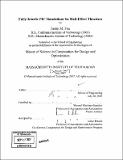| dc.contributor.advisor | Manual Martinez-Sanchez. | en_US |
| dc.contributor.author | Fox, Justin M., 1981- | en_US |
| dc.contributor.other | Massachusetts Institute of Technology. Computation for Design and Optimization Program. | en_US |
| dc.date.accessioned | 2008-05-19T16:13:02Z | |
| dc.date.available | 2008-05-19T16:13:02Z | |
| dc.date.copyright | 2007 | en_US |
| dc.date.issued | 2007 | en_US |
| dc.identifier.uri | http://hdl.handle.net/1721.1/41733 | |
| dc.description | Thesis (S.M.)--Massachusetts Institute of Technology, Computation for Design and Optimization Program, 2007. | en_US |
| dc.description | Includes bibliographical references (p. 173-177). | en_US |
| dc.description.abstract | In recent years, many groups have numerically modeled the near-anode region of a Hall thruster in attempts to better understand the associated physics of thruster operation. Originally, simulations assumed a continuum approximation for electrons and used magnetohydrodynamic fluid equations to model the significant processes. While these codes were computationally efficient, their applicability to non-equilibrated regions of the thruster, such as wall sheaths, was limited, and their accuracy was predicated upon the notion that the energy distributions of the various species remained Maxwellian at all times. The next generation of simulations used the fully-kinetic particle-in-cell (PIC) model. Although much more computationally expensive than the fluid codes, the full-PIC codes allowed for non-equilibrated thruster regions and did not rely on Maxwellian distributions. However, these simulations suffered for two main reasons. First, due to the high computational cost, fine meshing near boundaries which would have been required to properly resolve wall sheaths was often not attempted. Second, PIC is inherently a statistically noisy method and often the extreme tails of energy distributions would not be adequately sampled due to high energy particle dissipation. The current work initiates a third generation of Hall thruster simulation. A PIC-Vlasov hybrid model was implemented utilizing adaptive meshing techniques to enable automatically scalable resolution of fine structures during the simulation. The code retained the accuracy and versatility of a PIC simulation while intermittently recalculating and smoothing particle distribution functions within individual cells to ensure full velocity space coverage. A non-Monte Carlo collision technique was also implemented to reduce statistical noise. | en_US |
| dc.description.abstract | (cont.) This thesis details the implementation and thorough benchmarking of that new simulation. The work was conducted with the aid of Delta Search Labs' supercomputing facility and technical expertise. The simulation was fully-parallelized using MPI and tested on a 128 processor SGI Origin machine. We gratefully acknowledge that funding for portions of this work has been provided by the United States Air Force Research Laboratory and the National Science Foundation. | en_US |
| dc.description.statementofresponsibility | by Justin M. Fox. | en_US |
| dc.format.extent | 177 p. | en_US |
| dc.language.iso | eng | en_US |
| dc.publisher | Massachusetts Institute of Technology | en_US |
| dc.rights | M.I.T. theses are protected by
copyright. They may be viewed from this source for any purpose, but
reproduction or distribution in any format is prohibited without written
permission. See provided URL for inquiries about permission. | en_US |
| dc.rights.uri | http://dspace.mit.edu/handle/1721.1/7582 | en_US |
| dc.subject | Computation for Design and Optimization Program. | en_US |
| dc.title | Fully-kinetic PIC simulations for Hall-effect thrusters | en_US |
| dc.title.alternative | Fully-kinetic particle-in-cell simulations for Hall-effect thrusters | en_US |
| dc.type | Thesis | en_US |
| dc.description.degree | S.M. | en_US |
| dc.contributor.department | Massachusetts Institute of Technology. Computation for Design and Optimization Program | |
| dc.identifier.oclc | 225091468 | en_US |
